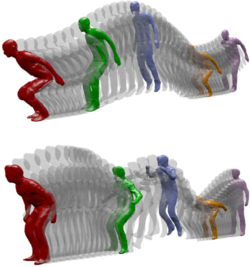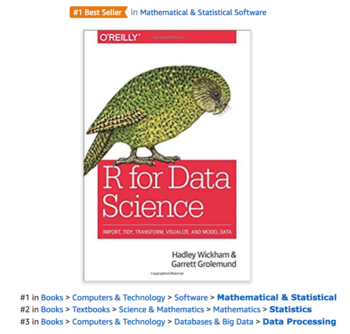Stochastic Processes: mudanças entre as edições
(→Links) |
|||
| (83 revisões intermediárias pelo mesmo usuário não estão sendo mostradas) | |||
| Linha 1: | Linha 1: | ||
This is the main page of an undergraduate-level course in stochastic processes targeted at engineering students (mainly computer engineering and its interface with mechanical engineering), being taught in | This is the main page of an undergraduate-level course in stochastic processes targeted at engineering students (mainly computer engineering and its interface with mechanical engineering), being taught in 2022 (2022.2 period) at the Polytechnic Institute [http://pt.wikipedia.org/wiki/IPRJ IPRJ]/UERJ. | ||
Previous periods: [[Stochastic_Processes_2022.2|2022.2]], [[Stochastic_Processes_2021_condensed|2021 condensed]], [[Stochastic_Processes_2021.2_2022|2021.2 (2022)]]. | |||
[[Image:Mocap_transfer.png|right|250px|thumb|Recent application of [https://en.wikipedia.org/wiki/Gaussian_process Gaussian stochastic processes] for 3D motion capture transfer [http://openaccess.thecvf.com/content_cvpr_2017/papers/Boukhayma_Surface_Motion_Capture_CVPR_2017_paper.pdf (CVPR 2017)] ]] | [[Image:Mocap_transfer.png|right|250px|thumb|Recent application of [https://en.wikipedia.org/wiki/Gaussian_process Gaussian stochastic processes] for 3D motion capture transfer [http://openaccess.thecvf.com/content_cvpr_2017/papers/Boukhayma_Surface_Motion_Capture_CVPR_2017_paper.pdf (CVPR 2017)] ]] | ||
| Linha 11: | Linha 11: | ||
== General Info == | == General Info == | ||
* Instructor: prof. [http:// | * Instructor: prof. [http://rfabbri.github.io Ricardo Fabbri], Ph.D. Brown University | ||
* Meeting times | * Meeting times (in-person): tuesdays T2,T3 and wednesdays T6,N1. | ||
* | * Chat: IRC #labmacambira for random chat | ||
=== Pre-requisites === | === Pre-requisites === | ||
| Linha 22: | Linha 21: | ||
=== Software === | === Software === | ||
The R programming language and data exploration environment will be used for learning, with others used occasionally. Students can also choose to do their homework in Python, Scilab, Matlab or similar languages. The R language has received growing attention, specially in the past couple of years, but it is simple enough so that the student can adapt the code to his preferred language. '''Students are expected to learn any of these languages on their own as needed, by doing tutorials and asking questions''' | The R programming language and data exploration environment will be used for learning, with others used occasionally. Students can also choose to do their homework in Python, Scilab, Matlab or similar languages. The R language has received growing attention, specially in the past couple of years, but it is simple enough so that the student can adapt the code to his preferred language. '''Students are expected to learn any of these languages on their own as needed, by doing tutorials and asking questions''' | ||
* [https://www.rstudio.com/products/rstudio/download/preview/ R studio]: recommended IDE for R. | |||
* [http://rich-iannone.github.io/DiagrammeR Diagrammer]: beautiful tool to draw and interact with graphs in R. | |||
== Approximate Content == | == Approximate Content == | ||
| Linha 29: | Linha 30: | ||
== Main Resources == | == Main Resources == | ||
=== Textbooks === | === Textbooks === | ||
Check out the moodle student shelf. | |||
==== Main book ==== | ==== Main book ==== | ||
[https://books.google.com.br/books/about/Introduction_to_Stochastic_Processes_wit.html?id=CQ2ACgAAQBAJ&redir_esc=y&hl=en ''Introduction to Stochastic Processes with R''], Robert Dobrow, 2016 (5 stars on Amazon) [[Image:Book-R.jpg|130px]] | [https://books.google.com.br/books/about/Introduction_to_Stochastic_Processes_wit.html?id=CQ2ACgAAQBAJ&redir_esc=y&hl=en ''Introduction to Stochastic Processes with R''], Robert Dobrow, 2016 (5 stars on Amazon) [[Image:Book-R.jpg|130px]] | ||
| Linha 37: | Linha 40: | ||
* ''An Introduction to Stochastic Modeling'', Taylor & Karlin | * ''An Introduction to Stochastic Modeling'', Taylor & Karlin | ||
* ''Pattern Theory: The Stochastic Analysis of Real-World Signals'', David Mumford and Agnes Desolneux - the first chapters already cover many types of stochastic processes in text, signal and image AI [[Image:Mumford-book.jpg]] | * ''Pattern Theory: The Stochastic Analysis of Real-World Signals'', David Mumford and Agnes Desolneux - the first chapters already cover many types of stochastic processes in text, signal and image AI [[Image:Mumford-book.jpg]] | ||
* My own machine learning and computational modeling book draft, co-written with prof. Francisco Duarte Moura Neto and focused on diffusion processes on graphs like PageRank. There is a probability chapter which is the basis for this course | * My own machine learning and computational modeling book draft, co-written with prof. Francisco Duarte Moura Neto and focused on diffusion processes on graphs like PageRank. There is a probability chapter which is the basis for this course. | ||
==== Other books to look at ==== | ==== Other books to look at ==== | ||
| Linha 52: | Linha 55: | ||
=== Lectures === | === Lectures === | ||
Lectures roughly follow the sequence of our main book, with some additional material as needed. All necessary background will be covered as needed. Advanced material will be covered partly. | Lectures roughly follow the sequence of our main book, with some additional material as needed. All necessary background will be covered as needed. Advanced material will be covered partly. | ||
==== Public Youtube Playlist (Portuguese) ==== | |||
Prof. Fabbri's lectures are publically available online at: | |||
https://www.youtube.com/playlist?list=PL1tkMA9lsTiVw9PzRcxpUBN4aArh948sK | |||
Partial listing: | |||
* Aula 1 parte 1 Introdução ao Curso https://youtu.be/qTZkZ5y_MJc | |||
* Aula 1 parte 2 O que são Processos Estocásticos? https://youtu.be/hDVdjPTVJtw | |||
* Aula 1 parte 3 O que significa "estocástico"? https://youtu.be/xUSvDqRXAL4 | |||
* Aula 1 parte 4 Formalismo e revisão de probabilidades https://youtu.be/pawQt7TtIf0 | |||
* Aula 1 parte 5 Exemplos Iniciais https://youtu.be/L5zH-uSDejc | |||
* Aula 1 parte 6 Exemplos 2, Difusões https://youtu.be/tYD0ezDfYxM | |||
* Aula 2 parte 1 Revisão de Probabilidade parte 2 | |||
* Aula 2 parte 2 Revisão de Distribuições - Revisão de Probabilidade parte 3 https://youtu.be/admtZDT2iok | |||
* Aula 3 parte 1 Pagerank https://youtu.be/45wx3yZh7SI | |||
* Aula 3 parte 2 Grafos - Revisão https://youtu.be/cE834FfnnuY | |||
* Aula 4 parte 1 Cadeias de Markov e exemplo em Metástase do Câncer https://youtu.be/N0R83bBUSf8 | |||
** Paper: Spatiotemporal progression of metastatic breast cancer: a Markov chain model highlighting the role of early metastatic sites., Newton, P., Mason, J., Venkatappa, N. et al., Nature npj Breast Cancer 1, 15018 (2015). https://doi.org/10.1038/npjbcancer.2015.18 | |||
** Paper: A Stochastic Markov Chain Model to Describe Lung Cancer Growth and Metastasis | |||
Newton PK, Mason J, Bethel K, Bazhenova LA, Nieva J, et al. (2012) A Stochastic Markov Chain Model to Describe Lung Cancer Growth and Metastasis. PLOS ONE 7(4): e34637. https://doi.org/10.1371/journal.pone.0034637 | |||
* Remaining lectures ongoing at: https://www.youtube.com/playlist?list=PL1tkMA9lsTiVw9PzRcxpUBN4aArh948sK | |||
==== Lecture Notes ==== | |||
* Fabbri's lecture notes on long term markov chains (based on Dobrow's Chapter 3) [https://drive.google.com/file/d/1FVCbiH32Up4_NHzBLhuFd6tn0GN2FmX0/view?usp=sharing pdf] | |||
==== Tentative listing ==== | ==== Tentative listing ==== | ||
* Intro, overview of main processes and quick review | * Intro, overview of main processes and quick review | ||
* Markov Chains | * Markov Chains | ||
* Markov Chain Monte Carlo: MCMC | * Markov Chain Monte Carlo: MCMC | ||
* Poisson Process | * Poisson Process | ||
| Linha 68: | Linha 95: | ||
* If you do the homework in two different languages, you get double the homework grade (bonus of 100%) | * If you do the homework in two different languages, you get double the homework grade (bonus of 100%) | ||
* Late homework will be accepted but penalized at the professor's will according to how late it is | * Late homework will be accepted but penalized at the professor's will according to how late it is | ||
* '''All electronic material must be sent to the professors' email, with the string "[iprj-pe]" as part of the subject of the email. You will receive an automatic confirmation.''' | |||
=== Assignment 0 === | === Assignment 0 === | ||
* | * Exercise 1.1 of the main book | ||
* | * Suggested due date: Before thursday of the 2nd week. | ||
=== Assignment 1 === | === Assignment 1 === | ||
* Exercise 1 Ch1 of the Pattern Theory book by Mumford & Desolneux, | * Exercise 1 Ch1 of the Pattern Theory book by Mumford & Desolneux, | ||
''Simulating Discrete Random Variables'' (pp 51, 52, 53) | ''Simulating Discrete Random Variables'' (pp 51, 52, 53) | ||
* No need to read this book for this exercise. You will review discrete random variables in the context of Markov chains for natural language processing; this is basic for most AI bots nowadays. If you're curious about the applications, you can read the book chapter just for fun. | * No need to read this book for this exercise. You will review discrete random variables in the context of Markov chains for natural language processing; this is basic for most AI bots nowadays. If you're curious about the applications, you can read the book chapter just for fun. | ||
* Suggested due date: Before Thursday of the 3rd week. | |||
=== Assignment 2: Exercise list for chapter 1 === | |||
7 Exercises: 1.3, 1.5, 1.6, 1.7, 1.9, 1.10, 1.19 | |||
* Suggested due date: at least 1 week before P1 (suggested) | |||
=== Assignment 3: Exercise list for chapter 2 === | |||
11 Exercises: 2.1, 2.4, 2.6, 2.8, 2.9, 2.10, 2.12, 2.14, 2.15, 2.18 | |||
Computer: 2.26 | |||
* Due date: before P1 (suggested) | |||
=== Assignment 4: Exercise list for chapter 3 === | |||
Exercises: 3.2, 3.5a-c, 3.10a-d, 3.16i-iv, 3.25a-b, 3.37, 3.58 | |||
* Due date: before P1 (suggested) | |||
=== Assignment 5: Exercise list for chapter 5 (MCMC) === | |||
4 Exercises: 5.1, 5.2, 5.5, 5.6 | |||
* Due date: before P2 (suggested) | |||
=== Assignment 6: Exercise list for chapter 6 === | |||
4 Exercises: 6.3, 6.4, 6.7, 6.8 | |||
* Due date: before P2 (suggested) | |||
== Exams == | == Exams == | ||
* '''P1 | * '''P1:''' ter19set23 | ||
* '''P2 | * '''P2:''' ter17out23 | ||
* '''Final-Sub:''' | * '''Final-Sub:''' ter19dez2 | ||
== Evaluation criteria == | == Evaluation criteria == | ||
< | <pre> | ||
P = (P1 + P2)/2 | |||
N = 0.9P + 0.1T | |||
Onde T = nota de todos tabalhos e tarefas. | |||
if N >= 7 --> passa direto, final opcional | |||
if 4 <= N < 7 --> final obrigatoria | |||
if N < 4 --> reprova direto | |||
M = (F + N)/2 para os que fizerem final | |||
if M >= 5 --> passa | |||
</ | else reprova | ||
</pre> | |||
== Awesome Links == | == Awesome Links == | ||
| Linha 109: | Linha 157: | ||
* Paper: Variational Bayesian Multiple Instance Learning with Gaussian Processes, CVPR 2017 | * Paper: Variational Bayesian Multiple Instance Learning with Gaussian Processes, CVPR 2017 | ||
* Paper: Correlational Gaussian Processes for Cross-domain Visual Recognition, CVPR 2017 | * Paper: Correlational Gaussian Processes for Cross-domain Visual Recognition, CVPR 2017 | ||
* COPPE Sistemas curso CPS767 - 2021/1 - Algoritmos de Monte Carlo e Cadeias de Markov https://www.cos.ufrj.br/~daniel/mcmc/ playlist: https://www.youtube.com/watch?v=sDUaMoMkmGc&list=PLP0bYj2MTFcs8yyA-Y4GYNahJWiZk2iOu | |||
* Course pages for previous years: '''[[PE2020 (canceled)|2020/1a (Canceled due to COVID-19)]], [[PE2019|2019]], [[PE2018|2018]], [[PE2012|2012]]''' | |||
=== Neural Nets and Stochastic Processes === | === Neural Nets and Stochastic Processes === | ||
Edição atual tal como às 16h46min de 16 de agosto de 2023
This is the main page of an undergraduate-level course in stochastic processes targeted at engineering students (mainly computer engineering and its interface with mechanical engineering), being taught in 2022 (2022.2 period) at the Polytechnic Institute IPRJ/UERJ.
Previous periods: 2022.2, 2021 condensed, 2021.2 (2022).
-
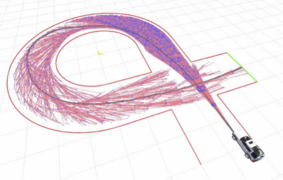 Application to path planning for autonomos cars (see this)
Application to path planning for autonomos cars (see this) -
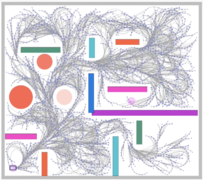 Application to robot path planning with obstacles (see this)
Application to robot path planning with obstacles (see this)
General Info
- Instructor: prof. Ricardo Fabbri, Ph.D. Brown University
- Meeting times (in-person): tuesdays T2,T3 and wednesdays T6,N1.
- Chat: IRC #labmacambira for random chat
Pre-requisites
- Undergraduate-level mathematics and probability (will review as needed)
- Desirable: Intermediate programming experience with any numerics scripting language such as Scilab, Python, R or Matlab. Knowing at least one of them will help you learn any new language needed in the course.
Software
The R programming language and data exploration environment will be used for learning, with others used occasionally. Students can also choose to do their homework in Python, Scilab, Matlab or similar languages. The R language has received growing attention, specially in the past couple of years, but it is simple enough so that the student can adapt the code to his preferred language. Students are expected to learn any of these languages on their own as needed, by doing tutorials and asking questions
- R studio: recommended IDE for R.
- Diagrammer: beautiful tool to draw and interact with graphs in R.
Approximate Content
This year's course will focus on a modern approach bridging theory and practice. As engineers and scientists, you should not learn theory here without also considering broader applications. Recent applications in artificial intelligence, machine learning, robotics, autonomous driving, material science and other topics will be considered. These applications are often too hard to tackle at the level of this course, but having contact with them will help motivate the abstract theory. We will try to focus on key concepts and more realistic applications than most courses (that come from the 1900's), that will prompt us to elaborate theory.
Main Resources
Textbooks
Check out the moodle student shelf.
Main book
Introduction to Stochastic Processes with R, Robert Dobrow, 2016 (5 stars on Amazon) 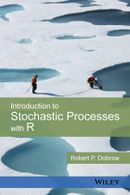
Additional books used in the course
Learning stochastic processes will require aditional books, including more traditional ones:
- Markov Chains: gibbs fields, monte carlo simulation and queues, Pierre Bremaud
- An Introduction to Stochastic Modeling, Taylor & Karlin
- Pattern Theory: The Stochastic Analysis of Real-World Signals, David Mumford and Agnes Desolneux - the first chapters already cover many types of stochastic processes in text, signal and image AI
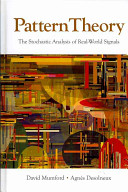
- My own machine learning and computational modeling book draft, co-written with prof. Francisco Duarte Moura Neto and focused on diffusion processes on graphs like PageRank. There is a probability chapter which is the basis for this course.
Other books to look at
Basic probability and statistics
- I recommend you review from the above books. They all include a review. But you might have to see:
- Elementary Statistics, Mario Triola (passed down to me by a great scientist and statistician)
Interesting books
Machine Learning
- Pattern Theory: From Representation to Inference, Ulf Grenader
Lectures
Lectures roughly follow the sequence of our main book, with some additional material as needed. All necessary background will be covered as needed. Advanced material will be covered partly.
Public Youtube Playlist (Portuguese)
Prof. Fabbri's lectures are publically available online at:
https://www.youtube.com/playlist?list=PL1tkMA9lsTiVw9PzRcxpUBN4aArh948sK
Partial listing:
- Aula 1 parte 1 Introdução ao Curso https://youtu.be/qTZkZ5y_MJc
- Aula 1 parte 2 O que são Processos Estocásticos? https://youtu.be/hDVdjPTVJtw
- Aula 1 parte 3 O que significa "estocástico"? https://youtu.be/xUSvDqRXAL4
- Aula 1 parte 4 Formalismo e revisão de probabilidades https://youtu.be/pawQt7TtIf0
- Aula 1 parte 5 Exemplos Iniciais https://youtu.be/L5zH-uSDejc
- Aula 1 parte 6 Exemplos 2, Difusões https://youtu.be/tYD0ezDfYxM
- Aula 2 parte 1 Revisão de Probabilidade parte 2
- Aula 2 parte 2 Revisão de Distribuições - Revisão de Probabilidade parte 3 https://youtu.be/admtZDT2iok
- Aula 3 parte 1 Pagerank https://youtu.be/45wx3yZh7SI
- Aula 3 parte 2 Grafos - Revisão https://youtu.be/cE834FfnnuY
- Aula 4 parte 1 Cadeias de Markov e exemplo em Metástase do Câncer https://youtu.be/N0R83bBUSf8
- Paper: Spatiotemporal progression of metastatic breast cancer: a Markov chain model highlighting the role of early metastatic sites., Newton, P., Mason, J., Venkatappa, N. et al., Nature npj Breast Cancer 1, 15018 (2015). https://doi.org/10.1038/npjbcancer.2015.18
- Paper: A Stochastic Markov Chain Model to Describe Lung Cancer Growth and Metastasis
Newton PK, Mason J, Bethel K, Bazhenova LA, Nieva J, et al. (2012) A Stochastic Markov Chain Model to Describe Lung Cancer Growth and Metastasis. PLOS ONE 7(4): e34637. https://doi.org/10.1371/journal.pone.0034637
- Remaining lectures ongoing at: https://www.youtube.com/playlist?list=PL1tkMA9lsTiVw9PzRcxpUBN4aArh948sK
Lecture Notes
- Fabbri's lecture notes on long term markov chains (based on Dobrow's Chapter 3) pdf
Tentative listing
- Intro, overview of main processes and quick review
- Markov Chains
- Markov Chain Monte Carlo: MCMC
- Poisson Process
- Queue theory
- Brownian Motion
- Stochastic Calculus
Homework
- All homework can be done in any language. Most are either in the R programming language or in Scilab/Matlab and Python.
- If you do the homework in two different languages, you get double the homework grade (bonus of 100%)
- Late homework will be accepted but penalized at the professor's will according to how late it is
- All electronic material must be sent to the professors' email, with the string "[iprj-pe]" as part of the subject of the email. You will receive an automatic confirmation.
Assignment 0
- Exercise 1.1 of the main book
- Suggested due date: Before thursday of the 2nd week.
Assignment 1
- Exercise 1 Ch1 of the Pattern Theory book by Mumford & Desolneux,
Simulating Discrete Random Variables (pp 51, 52, 53)
- No need to read this book for this exercise. You will review discrete random variables in the context of Markov chains for natural language processing; this is basic for most AI bots nowadays. If you're curious about the applications, you can read the book chapter just for fun.
- Suggested due date: Before Thursday of the 3rd week.
Assignment 2: Exercise list for chapter 1
7 Exercises: 1.3, 1.5, 1.6, 1.7, 1.9, 1.10, 1.19
- Suggested due date: at least 1 week before P1 (suggested)
Assignment 3: Exercise list for chapter 2
11 Exercises: 2.1, 2.4, 2.6, 2.8, 2.9, 2.10, 2.12, 2.14, 2.15, 2.18 Computer: 2.26
- Due date: before P1 (suggested)
Assignment 4: Exercise list for chapter 3
Exercises: 3.2, 3.5a-c, 3.10a-d, 3.16i-iv, 3.25a-b, 3.37, 3.58
- Due date: before P1 (suggested)
Assignment 5: Exercise list for chapter 5 (MCMC)
4 Exercises: 5.1, 5.2, 5.5, 5.6
- Due date: before P2 (suggested)
Assignment 6: Exercise list for chapter 6
4 Exercises: 6.3, 6.4, 6.7, 6.8
- Due date: before P2 (suggested)
Exams
- P1: ter19set23
- P2: ter17out23
- Final-Sub: ter19dez2
Evaluation criteria
P = (P1 + P2)/2 N = 0.9P + 0.1T Onde T = nota de todos tabalhos e tarefas. if N >= 7 --> passa direto, final opcional if 4 <= N < 7 --> final obrigatoria if N < 4 --> reprova direto M = (F + N)/2 para os que fizerem final if M >= 5 --> passa else reprova
Awesome Links
- Course on robotic path planning with applications of stochastic processes: https://natanaso.github.io/ece276b/schedule.html
- Paper: Markovian robots: minimal navigation strategies for active particles, Arxiv 2017
- Paper: Stochastic processes in vision: from Langevin to Beltrami https://ieeexplore.ieee.org/document/937531/
- Cool applications: https://math.stackexchange.com/questions/1543211/which-research-groups-use-stochastic-processes-and-or-stochastic-differential-eq
- Paper: Building Blocks for Computer Vision with Stochastic Partial Differential Equations https://link.springer.com/article/10.1007/s11263-008-0145-5
- Paper: Variational Bayesian Multiple Instance Learning with Gaussian Processes, CVPR 2017
- Paper: Correlational Gaussian Processes for Cross-domain Visual Recognition, CVPR 2017
- COPPE Sistemas curso CPS767 - 2021/1 - Algoritmos de Monte Carlo e Cadeias de Markov https://www.cos.ufrj.br/~daniel/mcmc/ playlist: https://www.youtube.com/watch?v=sDUaMoMkmGc&list=PLP0bYj2MTFcs8yyA-Y4GYNahJWiZk2iOu
- Course pages for previous years: 2020/1a (Canceled due to COVID-19), 2019, 2018, 2012
Neural Nets and Stochastic Processes
- Generative Models for Stochastic Processes Using Convolutional Neural Networks, arxiv, pesquisadores brasileiros (USP)
- Bayesian SegNet: Model Uncertainty in Deep Convolutional Encoder-Decoder Architectures for Scene Understanding, Cipolla et. al arxiv 2016
Keywords
random fields, stochastic modeling, data science, queue theory, machine learning, poisson process, markov chains, Gaussian processes, Bernoulli processes, soft computing, random process, Brownian motion, robot path planning, artificial intelligence, simulation, sampling, pattern formation, signal processing, text processing, image processing, dimentionality reduction, diffusion, Markov Chain Monte Carlo MCMC, tracking, branching process, stochastic calculus, SDEs
